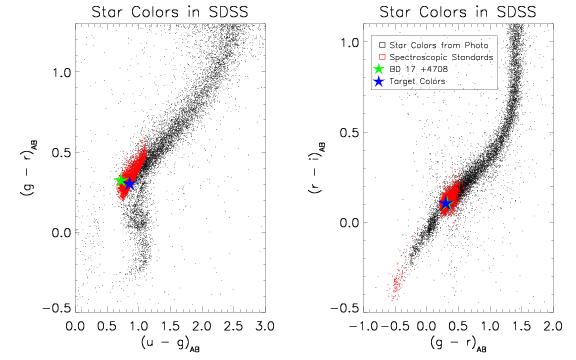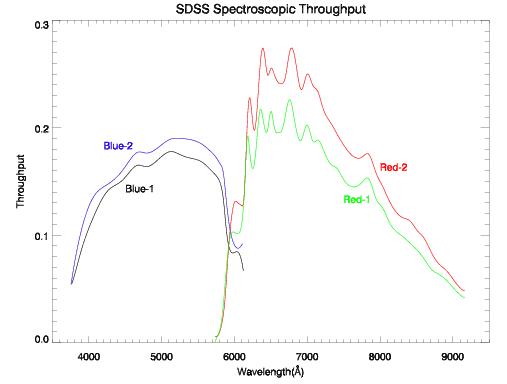
| Home |
| Where to Start |
| About DR6 |
| News and Updates |
| Tutorials |
| Data Products |
| Data Access |
| Sky Coverage |
| Instruments |
| Data Flow |
| Algorithms |
| Glossary |
| Known Problems |
| Help and Feedback |
| Search |
 |
Algorithms - SpectrophotometryBecause the SDSS spectra are obtained through 3-arcsecond fibers
during non-photometric observing conditions, special techniques must
be employed to spectrophotometrically calibrate the data. In DR6,
there have been substantial improvements to the algorithms which
photometrically calibrate the spectra, and all spectra have been
re-reduced, with a new spectro rerun number (sometimes called
DR6 updatesThe pipeline that extracts, combines, and calibrates the SDSS
spectra of individual objects from the two-dimensional spectrograms
( The new code has a different spectrophotometric calibration flux scale. The fiber magnitude reported by the photometric pipeline is the brightness of each object, as measured through a 3′′ diameter aperture corrected to 2′′ seeing to match the entrance aperture of the fibers (see the discussion in the EDR paper). However, the relationship between the fiber magnitudes of stars and the PSF magnitudes (which, for unresolved objects, is our best determination of a true, total magnitude) is dependent on seeing; this is made worse because the colors of stars measured via fiber magnitudes will be sensitive to the different seeing in the different filters (although cases in which the seeing is dramatically different in the different bands are fairly rare). With this in mind, the pipeline used in DR6 determines the spectrophotometric calibration on each plate such that the flux of the spectrum of standard stars integrated over the filter curve matches the PSF magnitude of the stars as measured from their imaging. This calibration is determined for each of the four cameras (two in each spectrograph) from observations of standard stars. Additional corrections to handle large-scale astrometric and chromatic terms are measured from isolated stars and galaxies of high S/N, and are then applied to all the objects on the plate. Unchanged since DR2/DR3The following items have remained unchanged since DR2/DR3, which had the previous major change of SDSS spectrophotometry calibration. Selection of spectroscopic standard starsOn each spectroscopic plate, 16 objects are targeted as spectroscopic standards. These objects are color-selected to be F8 subdwarfs, similar in spectral type to the SDSS primary standard BD+17 4708. 
The color selection of the SDSS standard stars. Red points represent stars selected as spectroscopic standards. (Most are flux standards; the very blue stars in the right hand plot are"hot standards"used for telluric absorption correction.) The flux calibration of the spectra is handled by the Spectro2d pipeline. It is performed separately for each of the 2 spectrographs, hence each half-plate has its own calibration. In the EDR and DR1 Spectro2d calibration pipelines, fluxing was achieved by assuming that the mean spectrum of the stars on each half-plate was equivalent to a synthetic composite F8 subdwarf spectrum from Pickles (1998). In the reductions included in DR2/DR3, the spectrum of each standard star is spectrally typed by comparing with a grid of theoretical spectra generated from Kurucz model atmospheres (Kurucz 1992) using the spectral synthesis code SPECTRUM (Gray & Corbally 1994; Gray, Graham, & Hoyt 2001). The flux calibration vector is derived from the average ratio of each star (after correcting for Galactic reddening) and its best-fit model. Since the red and blue halves of the spectra are imaged onto separate CCDs, separate red and blue flux calibration vectors are produced. These will resemble the throughput curves under photometric conditions. Finally, the red and blue halves of each spectrum on each exposure are multiplied by the appropriate flux calibration vector. The spectra are then combined with bad pixel rejection and rebinned to a constant dispersion. 
Throughput curves for the red and blue channels on the two SDSS spectrographs. Note about galactic extinction correctionIn the EDR and DR1, the spectroscopic data were nominally corrected for galactic extinction. The spectrophotometry since DR2 is vastly improved compared to DR1, but the final calibrated spectra in DR2 and beyond are not corrected for foreground Galactic reddening (a relatively small effect; the median E(B-V) over the survey is 0.034). Users of spectra should note that the fractional improvement in spectrophotometry from DR1 to DR2 and beyond was much greater than the extinction correction itself. As the SDSS includes a substantial number of spectra of galactic stars, a decision has been taken not to apply any extinction correction to spectra, since it would only be appropriate for extragalactic objects, but to report the observational result of the SDSS, namely, the spectrum including galactic extinction. Last modified on $Date: 2007/09/13 19:48:44 $ (UT). |